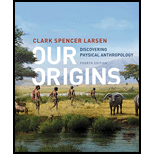
Concept explainers
Introduction: The coal serves as the major source of the fuel. However, the coal burning has many cumulative effects that causes many long-lasting environmental change. Thus scientist has named a new geological epoch termed as Anthropocene.
Explanation of Solution
Correct answer: Option b. The humanity’s role in changing the land and air of the planet.
Reasons for the correct answer:
The Anthropocene is the geological epoch that describes the alteration in the atmospheric, hydrologic, geological processes by the activity of humans.
Option b. is given as “humanity’s role in changing the land and air of the planet.”.
Hence the correct option is option b.
Reasons for the incorrect answers:
Option a. is given as “the industrialization of agriculture”. The Anthropocene does not describe the industrialization of agriculture instead it deals with the impact of human activity on environment. Hence, option a. is incorrect.
Option c. is given as “a natural warming of Earth’s atmosphere unrelated to human activity”. The Anthropocene deals with the impact of human activity on environment instead of natural warming. Hence, option c. is incorrect.
Option d. is given as “an end to the continued biological evolution of humans”. The Anthropocene deals with the impact of human activity on environment. Hence, option d. is incorrect.
Therefore, options a., c., and d. are incorrect.
Thus the Anthropocene is defined by humanity’s role in changing the land and air of the planet.
Want to see more full solutions like this?
Chapter 14 Solutions
Our Origins: Discovering Physical Anthropology (Fourth Edition)
- Not part of a graded assignment, from a past midtermarrow_forwardNoggin mutation: The mouse, one of the phenotypic consequences of Noggin mutationis mispatterning of the spinal cord, in the posterior region of the mouse embryo, suchthat in the hindlimb region the more ventral fates are lost, and the dorsal Pax3 domain isexpanded. (this experiment is not in the lectures).a. Hypothesis for why: What would be your hypothesis for why the ventral fatesare lost and dorsal fates expanded? Include in your answer the words notochord,BMP, SHH and either (or both of) surface ectoderm or lateral plate mesodermarrow_forwardNot part of a graded assignment, from a past midtermarrow_forward
- Explain in a flowcharts organazing the words down below: genetics Chromosomes Inheritance DNA & Genes Mutations Proteinsarrow_forwardplease helparrow_forwardWhat does the heavy dark line along collecting duct tell us about water reabsorption in this individual at this time? What does the heavy dark line along collecting duct tell us about ADH secretion in this individual at this time?arrow_forward
 Concepts of BiologyBiologyISBN:9781938168116Author:Samantha Fowler, Rebecca Roush, James WisePublisher:OpenStax College
Concepts of BiologyBiologyISBN:9781938168116Author:Samantha Fowler, Rebecca Roush, James WisePublisher:OpenStax College
 Biology (MindTap Course List)BiologyISBN:9781337392938Author:Eldra Solomon, Charles Martin, Diana W. Martin, Linda R. BergPublisher:Cengage Learning
Biology (MindTap Course List)BiologyISBN:9781337392938Author:Eldra Solomon, Charles Martin, Diana W. Martin, Linda R. BergPublisher:Cengage Learning Biology: The Dynamic Science (MindTap Course List)BiologyISBN:9781305389892Author:Peter J. Russell, Paul E. Hertz, Beverly McMillanPublisher:Cengage Learning
Biology: The Dynamic Science (MindTap Course List)BiologyISBN:9781305389892Author:Peter J. Russell, Paul E. Hertz, Beverly McMillanPublisher:Cengage Learning Human Biology (MindTap Course List)BiologyISBN:9781305112100Author:Cecie Starr, Beverly McMillanPublisher:Cengage Learning
Human Biology (MindTap Course List)BiologyISBN:9781305112100Author:Cecie Starr, Beverly McMillanPublisher:Cengage Learning Biology Today and Tomorrow without Physiology (Mi...BiologyISBN:9781305117396Author:Cecie Starr, Christine Evers, Lisa StarrPublisher:Cengage Learning
Biology Today and Tomorrow without Physiology (Mi...BiologyISBN:9781305117396Author:Cecie Starr, Christine Evers, Lisa StarrPublisher:Cengage Learning





